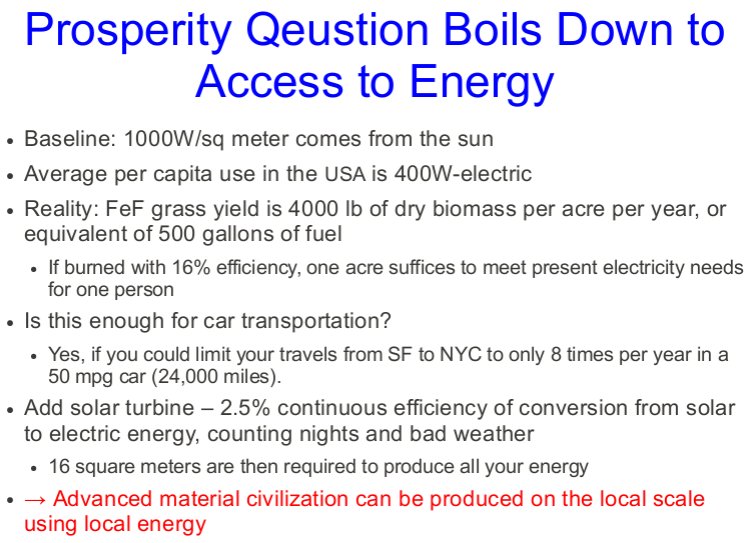Energy Literacy 101: Difference between revisions
(add link to (energy) withouthotair.com) |
mNo edit summary |
||
| Line 18: | Line 18: | ||
This is a good resource: http://www.withouthotair.com/ and maybe they can review this too. A "study group" might gather around this, with data-hunting crowdsourced at least a bit. [[User:LucasG|LucasG]] 00:01, 30 November 2010 (PST) | This is a good resource: http://www.withouthotair.com/ and maybe they can review this too. A "study group" might gather around this, with data-hunting crowdsourced at least a bit. [[User:LucasG|LucasG]] 00:01, 30 November 2010 (PST) | ||
[[Category:Energy]] | |||
Revision as of 02:12, 4 January 2011
The news are good. For electrical production, 1kW average US household consumption is replaced by 1/100 acre of solar concentrator.
For transportation - we can frame it as solar biomass (requires 1/2 acre per person for current average yearly mileage (12k miles/year, in a 50 mpg steam microcar), and 1/6 acre if we commute, say, 5k miles per year (100 miles/week, 50 mpg car) in well-designed, resilient communities. We can further make the claim that with integrated permacultural systems, we can produce both food and fuel without reducing the yields of either. This is quite controversial, but we can back this up completely by pointing to sustainable forestly biomass yields, and extrapolating to the case wherein that biomass crop is a perennial food staple, such as chestnut and hazelnut polyculture with other intercropping.
We can take that down to 1/200 acre (extrapolated from wattzon.com, which reveals that 400 Watts are required to power a car at the 5k mi/yr level). This occurs if we use the concentrator to produce electricity to power pure electric cars. For hybrid cars, this figure would be somewhere in between.
The average consumption for the entire industrial system is 7 kW/person (outside of home electric use). This means with 100% solar concentrator to produce industrial power, we need 1/15 acre (to accommodate the current design-for-obsolescence lifestyle). By applying lifetime design and efficiency, we can make a claim of one tenth this, or less than 1/100 acre per person.
The energy issue is a nonissue, readily solved by what I mentioned above. I suspect that because the proposition above is so pedestrian that it does not fit in with the popular paradigm that everything has to be so complicated.
We should produce a rigorous study of the above, with peer review, as part of our Proposal. I should spend about one week on that to nail this down. The only problem is that very few people have the technical polymath capacity to assess such a study, which makes such a study less valuable than if people actually understood it. Amory and Hunter Lovins would be good people to review this, as would the Princeton Center for Energy and Environmental Studies.
Did you mention a paper which discussed why biofuel crop cannot work? I'd like to review that.
Experts will dismiss the above as the words of Amish on crack. They have different assumptions, and do not see either steam power or solar concentrators as economically feasible options. We should go through wide 'peer review' from these people, so we can laugh at them (ie, show to society how backwards our leadership is as part of a study in cultural transformation) in 2 years when we demonstrate the above in practice.
This is a good resource: http://www.withouthotair.com/ and maybe they can review this too. A "study group" might gather around this, with data-hunting crowdsourced at least a bit. LucasG 00:01, 30 November 2010 (PST)
